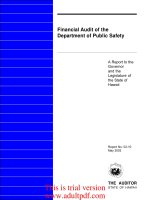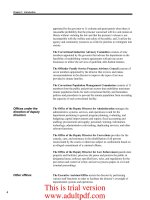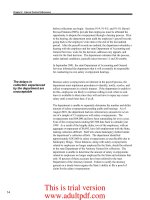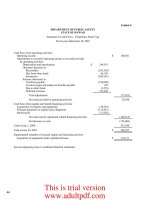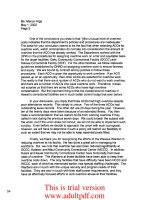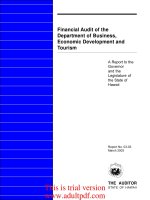Financial Audit of the Department of Public Safety A Report to the Governor and the Legislature _part3 pot
Bạn đang xem bản rút gọn của tài liệu. Xem và tải ngay bản đầy đủ của tài liệu tại đây (327.2 KB, 10 trang )
14
Chapter 2: Internal Control Deficiencies
before collections can begin. Sections 91-9, 91-9.5, and 91-10, Hawaii
Revised Statutes (HRS), provide that employees must be afforded the
opportunity to dispute the overpayment through a hearing process. Prior
to the hearing, the department must audit the employee’s payroll records
going back to the employee’s hire date or the end of the last audited
period. After the payroll records are audited, the department schedules a
hearing with the employee and the state Department of Accounting and
General Services, waits for the decision, addresses any appeals, and
waits for the final decision. The department estimates that the process,
under optimal conditions, typically takes between 11 and 20 months.
In September 2001, the state Department of Accounting and General
Services informed the department that it will eventually be responsible
for conducting its own salary overpayment hearings.
Because salary overpayments are inherent in the payroll process, the
department must implement procedures to identify, notify, resolve, and
collect overpayments in a timely manner. If the department is unable to
do this, employees are likely to continue calling in sick when no sick
leave is available to them since they will not have to repay any excess
salary until a much later date, if at all.
The department is unable to separately determine the number and dollar
amount of salary overpayments pending audits and hearings. As of
August 2001, the department had not collected any amounts for seven
out of a sample of 15 employees with salary overpayments. The
overpayments total $84,000 and have been outstanding for over a year.
Four of the overpayments totaling $67,500 date back to calendar year
1999. As a result of the lengthy delay, two of the employees, with an
aggregate overpayment of $6,693, have left employment with the State,
making collection difficult. Staff who claim bankruptcy further hinder
the department’s collection efforts. The department identified
approximately $242,000 in salary overpayments as uncollectible due to
bankruptcy filings. These balances, along with salary overpayments
related to employees no longer employed by the State, should be referred
to the state Department of the Attorney General for collection. The
department is unable to determine the amount of salary overpayments
related to employees no longer employed by the State and estimates that
only 10 percent of these accounts have been referred to the state
Department of the Attorney General. Failure to notify the attorney
general on a timely basis negates the State’s ability to file a proof of
claim for the salary overpayments.
The delays in
collection experienced
by the department are
unacceptable
This is trial version
www.adultpdf.com
15
Chapter 2: Internal Control Deficiencies
We recommend that the department:
1. Perform required audits of salary overpayments in a timely manner
and in compliance with laws and regulations.
2. Reduce the backlog of pending audits by setting departmental goals
as to the number of audits and hearings to be performed each month.
(This number should be greater than the average number of salary
overpayments occurring each month.)
3. In preparation for the eventual responsibility of conducting hearings
related to salary overpayments, the department should immediately
develop plans to identify individuals who will conduct the hearings,
determine the time and location for the hearings, develop procedural
rules, and contact the state Department of Accounting and General
Services to review existing policies and procedures.
4. Consider contracting out the salary collection process on a
contingency basis in order to expedite the process and reduce the
amount of uncollectible payments.
The department is responsible for accounting for and safeguarding
inmates’ funds while they are incarcerated, withholding and remitting
restitution to victims, and providing child support to the families of
inmates. However, the department has not fulfilled its responsibilities in
these areas.
The department continues to fail in its efforts to comply with Section
353-20, HRS, which requires it to maintain individual ledgers for inmate
trust accounts. The inmate ledgers account for inmates’ earnings from
work, receipts from family and friends, and payments for store purchases
and other necessities. The department has a fiduciary responsibility to
the inmates to properly account for and safeguard approximately $1
million of funds belonging to inmates. The department’s implementation
of a new inmate trust accounting (ITA) system should have improved
management of the funds. However, implementation of the ITA system
has not resolved the department’s inability to reconcile inmate trust
account balances to bank balances, nor has it reduced the number of
inmate accounts related to released or paroled inmates.
Recommendations
The Department Is
Not Fulfilling Its
Fiduciary
Responsibilities to
the Inmates and
the Victims and
Families of the
Inmates
Management of inmate
trust accounts
continues to be a
problem
This is trial version
www.adultpdf.com
16
Chapter 2: Internal Control Deficiencies
The department does not reconcile inmate trust accounts to
bank balances
Reconciliation of accounting records to bank statements provides
assurance that funds are properly accounted for and prevents the theft or
misappropriation of funds. The inmate trust bank account at the
Women’s Community Correctional Center has not been reconciled since
1999. Additionally, for the other seven facilities, we found that the ITA
system balance did not equal the reconciled bank balance. Exhibit 2.2
details the ITA system balances, bank reconciliation balances, and
differences between the two for each facility.
Exhibit 2.2
ITA System Balances, Bank Reconciliation Balances,
and Differences Between the Balances for Each
Facility as of June 30, 2001
Bank ITA in excess
ITA System Reconciliation (less than) Bank
Facility Balance Balance Reconciliation
Halawa Correctional $363,523 $259,870 $103,653
Facility
Waiawa Correctional 57,352 65,657 (8,305)
Facility
Oahu Community 155,015 195,357 (40,342)
Correctional Center
Women's Community 36,078 * **
Correctional Center
Kulani Correctional 66,129 39,072 27,057
Facility
Hawaii Community 62,513 58,370 4,143
Correctional Center
Maui Community 147,074 137,983 9,091
Correctional Center
Kauai Community 64,055 63,505 550
Correctional Center
* The bank account has not been reconciled since 1999.
** Unable to determine the difference as the reconciled balance of the
bank account is unknown.
This is trial version
www.adultpdf.com
17
Chapter 2: Internal Control Deficiencies
The department reconciles the current month’s inmate account
transactions and does not perform a reconciliation between the ITA
system balance and the bank balance. We found discrepancies totaling
$21,000 between the ITA system and the reconciled bank balances
relating to transactions occurring between July 1, 2000 and June 30,
2001 for four facilities that had balances available for both dates. The
business office for each facility is responsible for reconciling the ITA
balances. The individuals responsible for performing the reconciliations
are not held accountable for completing the task. The lack of proper
reconciliation procedures makes it difficult to determine whether the
unreconciled differences were caused by accounting errors or possible
misappropriation of funds.
Unclaimed funds of paroled or released inmates are not
remitted to the Department of Budget and Finance
Upon parole or release of an inmate, the department prepares a check
payable to the inmate for the balance in his/her account. However, in
certain instances, such transactions as wages may not be posted to the
inmate trust account prior to the inmate’s parole or release. The
department informs the inmate that this may occur and requests the
inmate to return to collect the pending wages or leave a forwarding
address for a check to be mailed. If the inmate fails to return to collect
the remaining balance or if the mail is returned as undeliverable, the
department’s policy is to hold the balance for 180 days, at which time the
balance should be remitted to the Department of Budget and Finance for
escheat to the state.
The department did not remit any funds to the Department of Budget and
Finance during the fiscal year ended June 30, 2001. On June 30, 2001,
there were 2,554 inactive inmate accounts for paroled or released
inmates totaling approximately $107,800. Of these accounts, 1,833
totaling about $80,000 had been outstanding for over 180 days.
Furthermore, the Halawa Correctional Facility had 1,150 inactive inmate
accounts amounting to approximately $60,300 that dated back to 1990.
As a result, the department is holding substantial funds that belong to
former inmates or other parties.
State law requires the department to enforce court-issued, victim
restitution and child support orders. However, current departmental
policies and procedures do not ensure compliance with state statutes.
The department has failed to withhold inmate funds for victim restitution
and child support despite the fact that the inmates have available funds.
Compliance with these requirements is important to victims and families
because once the inmates leave custody, it is extremely difficult to
collect these amounts.
The department has
not fulfilled its
fiduciary responsibility
to victims and children
of inmates
This is trial version
www.adultpdf.com
18
Chapter 2: Internal Control Deficiencies
The department does not ensure that victim restitution and
child support are withheld and paid to the appropriate
agencies
Section 353-22.6, HRS, assigns responsibility to the department to
enforce victim restitution orders on wages earned by inmates while
incarcerated. The department should withhold 10 percent from the
prisoner’s annual earnings and should pay the amount withheld to the
victim. Despite the law, five out of the eight facilities failed to garnish
any inmate earnings for restitution. Only the Halawa Correctional
Facility, Waiawa Correctional Facility, and Oahu Community
Correctional Center withheld inmate earnings for restitution payments.
Furthermore, out of a sample of 20 inmates from the three facilities,
earnings for one inmate had not been withheld for over ten years.
Although 10 percent of the inmate’s earnings should have been
garnished since February 1990 in accordance with a court order, the
department only recently discovered the error and began deducting the
10 percent in June 2001. Additionally, the department does not plan to
garnish an estimated $400-$500 from the inmate’s wages earned between
February 1990 and May 2001. Departmental personnel informed us that
there may be other similar situations, but they could not estimate the
number of such instances.
As of June 30, 2001, the department had withheld restitution from 260
inmates totaling approximately $19,500. Of this amount, $17,000 has
not been remitted to the Judiciary for payment to the victims.
Approximately $5,000 of the amount was withheld in the fiscal year
ended June 30, 2001. The department currently does not have
procedures in place to identify and remit withheld restitution. The
current practice is to remit restitution to the Judiciary upon inmate
release, parole, or transfer between facilities. There have been instances
where restitution payments made to the Judiciary were remitted back to
the department because the Judiciary was not able to locate the victim.
These payments were credited back to the inmates’ accounts.
In addition, facility and fiscal staff informed us that the department does
not have procedures in place to identify inmates subject to court-ordered,
child support. The department only withholds and remits child support
to the Child Support Enforcement Agency (CSEA) when instructed by
the inmate. Court orders regarding child support are sent directly to the
inmate by CSEA instead of to the department. CSEA will only contact
the employer of the individual responsible for child support payments or
the individual himself. CSEA does not consider the department to be the
inmates’ employer and, as such, will not send court orders regarding
child support to the department.
This is trial version
www.adultpdf.com
19
Chapter 2: Internal Control Deficiencies
Basic internal controls and procedures need to be improved
The department has not implemented basic internal controls and
procedures to identify and monitor inmates subject to court-ordered,
victim restitution and child support, such as compiling and updating a
complete listing of all inmates subject to these court orders. Currently,
the department receives the court order for restitution upon
imprisonment of the inmate and enters the information into the system.
As noted earlier, it is possible the department may misplace or not be
provided with the court order; may incorrectly enter or fail to enter the
restitution information; or may not update the system when inmates are
transferred between facilities.
We recommend that the department:
1. Immediately reconcile inmate trust accounts to bank balances.
a. Assign responsibility for developing policies and procedures on
reconciling the inmate trust bank account to personnel able to
perform bank reconciliations and who are knowledgeable about
the ITA system.
2. Identify inactive inmate accounts outstanding over 180 days and
remit the balances to the Department of Budget and Finance.
3. Develop and implement a system whereby all court-ordered, victim
restitution and child support are identified and remitted to the proper
agencies on a quarterly or semi-annual basis.
a. Obtain on a monthly or quarterly basis a list from the Judiciary
and the CSEA of all inmates subject to court-ordered restitution
and child support and update department records to ensure
completeness and accuracy. For any inmates identified with
court orders dating back to previous periods and whose wages
have yet to be garnished for restitution and child support, the
department should calculate and remit the amounts related to
those previous periods to the appropriate agencies.
b. Clarify with CSEA and the Department of the Attorney General
whether child support orders can be sent directly to the
department. If possible, the department should obtain these
orders upon imprisonment of the inmate and enter the
information into its system.
Recommendations
This is trial version
www.adultpdf.com
20
Chapter 2: Internal Control Deficiencies
The department was unable to provide documentation to support the
reported value of its fixed assets amounting to $134 million. Invoices
supporting the cost of the fixed assets, especially for older fixed assets,
were not readily available. As a result, we were unable to determine if
the reported fixed assets balance was fairly presented in all material
respects. This will be extremely important to the department in fiscal
year ending June 30, 2002, when the department will be required by
Governmental Accounting Standards Board (GASB) Statement No. 34,
Basic Financial Statements – and Management’s Discussion and
Analysis – for State and Local Governments, to present financial
statements similar to business type organizations, including the
computation of depreciation expense for its fixed assets.
Also, the amount of fixed assets reported in the internal service fund on
June 30, 2001, exceeded the amount reported on the Annual Inventory
Report of Property by approximately $473,000.
If the department is unable to substantiate the cost basis of its general
fixed assets and is unable to reconcile the fixed assets posted in its
internal service fund to the annual physical inventory of property, the
department will not be able to comply with the requirements of GASB
Statement No. 34. The department’s external auditor will therefore be
unable to issue an unqualified opinion on the financial statements and
would have to qualify, disclaim, or issue an adverse opinion.
We recommend that the department immediately obtain documentation
to support the reported cost basis of all fixed assets, or if this information
is not available, obtain other information to support the assets value,
such as replacement cost estimates. The department should reconcile the
Annual Inventory Report of Property to the financial statements.
The Department Is
Unable to
Substantiate the
Cost Basis of Its
General Fixed
Assets and Is
Unable to
Reconcile the
Fixed Assets
Reported by the
Internal Service
Fund to the
Annual Physical
Inventory of
Property
Recommendation
This is trial version
www.adultpdf.com
21
Chapter 3: Financial Audit
Chapter 3
Financial Audit
This chapter presents the results of the financial audit of the Department
of Public Safety, State of Hawaii (department), as of and for the fiscal
year ended June 30, 2001. This chapter includes the independent
auditors’ report and the report on compliance and on internal control
over financial reporting based on an audit of financial statements
performed in accordance with Government Auditing Standards as they
relate to the department. It also displays the combined financial
statements of all fund types and account groups administered by the
department together with explanatory notes.
In the opinion of KPMG LLP, based on their audit, except for the
general fixed assets account group, the combined financial statements
present fairly, in all material respects, the financial position of the
department as of June 30, 2001, and the results of its operations and the
cash flows of its proprietary fund type for the year then ended in
conformity with accounting principles generally accepted in the United
States of America. KPMG LLP noted certain matters involving the
department’s internal control over financial reporting and its operations
that the firm considered to be reportable conditions. KPMG LLP also
noted that the results of its tests disclosed instances of noncompliance
that are required to be reported under Government Auditing Standards.
The Auditor
State of Hawaii:
We have audited the accompanying combined financial statements of the
Department of Public Safety, State of Hawaii (department), as of and for
the year ended June 30, 2001. These combined financial statements are
the responsibility of the department’s management. Our responsibility is
to express an opinion on these combined financial statements based on
our audit.
Except as discussed in the following paragraph, we conducted our audit
in accordance with auditing standards generally accepted in the United
States of America and the standards applicable to financial audits
contained in Government Auditing Standards, issued by the Comptroller
General of the United States. Those standards require that we plan and
perform the audit to obtain reasonable assurance about whether the
Summary of
Findings
Independent
Auditors’ Report
This is trial version
www.adultpdf.com
22
Chapter 3: Financial Audit
combined financial statements are free of material misstatement. An
audit includes examining, on a test basis, evidence supporting the
amounts and disclosures in the combined financial statements. An audit
also includes assessing the accounting principles used and significant
estimates made by management, as well as evaluating the overall
financial statement presentation. We believe that our audit provides a
reasonable basis for our opinion.
The department has not maintained adequate records to support the
amounts reported in the general fixed assets account group. It was
impracticable to extend our procedures sufficiently to determine the
extent to which the general fixed assets account group as of June 30,
2001 may have been affected by this condition. The assets and other
credit in the general fixed assets account group amounted to
$133,961,310 as of June 30, 2001.
In our opinion, except for the effects of such adjustments, if any, as
might have been determined to be necessary had we been able to apply
adequate procedures to the amounts reported in the general fixed assets
account group, as discussed in the preceding paragraph, the combined
financial statements referred to above present fairly, in all material
respects, the financial position of the Department of Public Safety, State
of Hawaii, as of June 30, 2001, and the results of its operations and the
cash flows of its proprietary fund type for the year then ended in
conformity with accounting principles generally accepted in the United
States of America.
As discussed in note 1, the combined financial statements of the
department are intended to present the financial position, results of
operations and cash flows of only that portion of the funds and account
groups of the State of Hawaii that is attributable to the transactions of the
department.
In accordance with Government Auditing Standards, we have also issued
our report dated November 30, 2001 on our consideration of the
department’s internal control over financial reporting and on our tests of
its compliance with certain provisions of laws, regulations, contracts, and
grants. That report is an integral part of an audit performed in
accordance with Government Auditing Standards and should be read in
conjunction with this report in considering the results of our audit.
Honolulu, Hawaii
November 30, 2001
This is trial version
www.adultpdf.com
23
Chapter 3: Financial Audit
The Auditor
State of Hawaii:
We have audited the combined financial statements of the Department of
Public Safety, State of Hawaii (department), as of and for the fiscal year
ended June 30, 2001, and have issued our report thereon dated November
30, 2001. Since we were not able to apply auditing procedures to satisfy
ourselves as to the amounts reported in the general fixed assets account
group, the scope of our work was not sufficient to enable us to express,
and we did not express, an opinion on the general fixed assets account
group as of June 30, 2001.
Except as discussed in the preceding paragraph, we conducted our audit
in accordance with auditing standards generally accepted in the United
States of America and the standards applicable to financial audits
contained in Government Auditing Standards, issued by the Comptroller
General of the United States.
Compliance
As part of obtaining reasonable assurance about whether the
department’s combined financial statements are free of material
misstatement, we performed tests of its compliance with certain
provisions of laws, regulations, contracts, and grants, including
applicable provisions of the Hawaii Public Procurement Code (Chapter
103D, Hawaii Revised Statutes) and procurement rules, directives, and
circulars, noncompliance with which could have a direct and material
effect on the determination of combined financial statement amounts.
However, providing an opinion on compliance with those provisions was
not an objective of our audit and, accordingly, we do not express such an
opinion. The results of our tests disclosed instances of noncompliance
that are required to be reported under Government Auditing Standards
and which are described in Chapter 2 of this report.
Internal Control Over Financial Reporting
In planning and performing our audit, we considered the department’s
internal control over financial reporting in order to determine our
auditing procedures for the purpose of expressing our opinion on the
combined financial statements and not to provide assurance on internal
control over financial reporting. However, we noted certain matters
involving the internal control over financial reporting and its operation
that we consider to be reportable conditions. Reportable conditions
involve matters coming to our attention relating to significant
deficiencies in the design or operation of internal control over financial
reporting that, in our judgment, could adversely affect the department’s
ability to record, process, summarize, and report financial data consistent
with the assertions of management in the combined financial statements.
Reportable conditions are described in Chapter 2 of this report.
Report on
Compliance and
on Internal Control
Over Financial
Reporting Based
on an Audit of
Financial
Statements
Performed in
Accordance with
Government
Auditing
Standards
This is trial version
www.adultpdf.com


